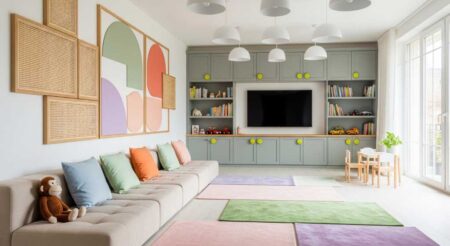Our homes mean so much more to us than simply being the places where we sleep and store our belongings; more, even, than places where we can work in this era of remote employment. They are environments which shape every area of our lives, affecting our emotions, impacting on our well-being, and coloring our everyday experiences. When designed with intention, a home can affect the senses in so many different ways, soothing, inspiring, and giving us energy.
From the colors on our walls and floors to the textures under our feet, every element of a home combines to make for an experience that is rich in sensory elements. If you want to create a home space that fully engages the senses, there are a number of tips and explanations below.
The Power of Sight: Using Color, Light and Visual Harmony

Sight is, for most of us, the first sense we engage when designing a space or considering changes. The way a room looks has profound influences on our mood and mindset, which makes color and lighting two of the key factors in sensory home design.
Color psychology is a factor worth considering in any changes you make to your home. It is recognized, for example, that soft blues and greens play a big part in promoting calm, while warmer hues such as orange and yellow engage energy and warmth. The right color choices for the relevant space can actively enhance its function; cool tones suit bedrooms as they encourage relaxation, while more lively shades boost connection in communal spaces.
Consider the effects of natural and artificial lighting, too. It’s undeniable that a wealth of natural light enhances personal well-being, and as the sun goes down a supply of warm artificial lighting can create a cozy feel. Layered lighting is important: overhead lighting bathes everything in a glow, while task lighting helps focus on projects or communal games; accent lights can also showcase parts of the home that you find particularly pleasing.
It’s also essential to embark on some decluttering. If you want a peaceful space where harmony is plentiful, visual stress isn’t going to help – and if you find yourself having to tiptoe between furniture and assorted elements, it’s not going to help. Ideally you should be able to look around the room and not see anything that doesn’t need to be there or doesn’t make you feel peaceful. Things can always be moved into and out of storage as they are needed.
The Sound of Serenity: Creating a Sonic Sanctuary

Sound plays a role in shaping our experience of home that is almost as important as that of sight. A home that runs to the sound of soothing noises can make a big difference to our sense of relaxation, and carefully-chosen background noise can make a big difference to your focus and productivity if working from home or embarking on a project.
Some soft furnishings can make a huge difference in the way your home sounds; rugs, curtains and well-upholstered furniture can actually absorb excess noise, making rooms feel quieter and affecting your peace in a positive way. If you occasionally notice echoes in your home, then adding a few fabric elements can make a difference you’ll notice right away.
The sounds you will most want to hear in your home are nature sounds, from the gentle babble of running water to some relaxing wind chimes. You don’t need to install a full fountain to get this benefit; tabletop water features can be an element of a kitchen remodel or simply an ad hoc addition to get some incidental noise that even covers up louder noises from outside.
While smart home technology is largely associated with bringing convenience and modernity to the home, it can absolutely help with the addition of soft music around the house as it provides a backdrop to the intended use of any room. As part of a bathroom renovation, it’s a good idea to integrate a smart speaker that can play ambient sounds or gentle instrumentals as you soak in the bathtub or carry out spa-like treatments. In the kitchen, meanwhile, you can play more upbeat tunes to soundtrack your cooking.
A Touch of Comfort: Textures that Make Life Softer

Sight and sound are important, for sure, but you can’t feel comfortable in your home unless you feel comfortable in your home, if you get our meaning. Texture is an often-overlooked element of home design. Homes can look bright and airy, sound peaceful and pleasant, but how they feel certainly matters. A balanced combination of textures can elevate a home from picture-perfect to something special in 3D. Don’t skimp on softness.
Always be on the lookout for ways you can add a little soothing sensory boost to your household setup. It may well start with soft furnishings such as plush rugs and thick throw blankets on surfaces where you expect to relax. People often call their living room the “lounge” for a reason, after all. Couches topped off with velvet cushions are the perfect place to kick back and forget the occasional harshness of the world.
It’s a good idea to prioritize natural materials where possible. Wooden seating in office spaces, stone floors in entryways (and matching this material on worktops), and woven fabrics can help with a sense of connection to the natural world. A linen table runner for the dining table or woven wall hangings will assist in this, and it is always smart to look for natural touches of decor such as ornamental ceramics or glassware.
Tying it All Together: How to Make it Work in Every Room

There are opportunities all over the house to make little additions that can maximize your sensory engagement. If you’re planning to shake things up a little in your home, it’s worth looking at elements in each room that can be overhauled in a positive way.
- Living room: Aim for a mix of soft textiles, integrated lighting and sources of sound that make this space ideal for relaxation, socializing, or working in comfort. Remember to keep it minimal; the more clutter there is, the harder it will be to fully relax in this space.
- Bedroom: In here, the decluttering should be even more complete. This is your personal space and you don’t want it to be too austere, but aim to keep it softly-lit, with natural materials and as few floor-cramping items as possible and a minimum of vertical interest; the bottom line is that you want to make it easy to drift off to sleep.
- Kitchen: Warm lighting is important in here, but nothing too dim – it’s a place where you prepare food so you want to be able to see very clearly. Scented candles and a few potted herbs will help with smell; meanwhile, earthenware jars will help you keep things organized and visually appealing.
- Bathroom: This space should feel like an oasis; think soft towels and soothing colors, with water sounds providing an escape from the stresses and strains. Some glass jars with bath salts can up the sensory game in this room.
There is a lot you can do to make little improvements in your home’s sensory offerings, but there is always the option of going for a bolder overhaul; if you’re looking for a big difference, then it might be time to consider a sensory remodel.
From a Few Small Touches to One Big Effort

Sometimes, you know that a few little tweaks aren’t going to get it done, and then it’s time to think bigger. If your home simply doesn’t align with your idea of a comforting, engaging space then it’s remodeling time, and this way you can make your comfort and sensory satisfaction the focus of the work.
It doesn’t need to be a whole house reshaping, though that is an option for sure. You can get a lot done just by focusing on specific rooms, and this has the additional benefit of not disturbing your communal spaces unduly in the meantime. Kitchens and bathrooms benefit most from the kind of remodeling that impacts your home’s sensory appeal while also boosting function.
You’ll gain a lot by upgrading fixtures to gain a more luxurious feel, prioritizing natural materials in the important rooms. Uplighting can help in the kitchen, giving you plenty of light to work with while avoiding being too dazzling. As smart technology improves, it’s easier to integrate tech like smart speakers, so you can have music or even a podcast flow from an unseen source – which can feel quite spooky initially, but you soon get used to it.
Aesthetics are important in a well-designed home, that will always be the case. But for the best impact, you can engage more senses and feel all the more comfortable in your living space. Think about any changes you make with the senses in mind and you’ll be happier with the result – both initially and more so as time goes on – and it’s things like this that make a house a home.








